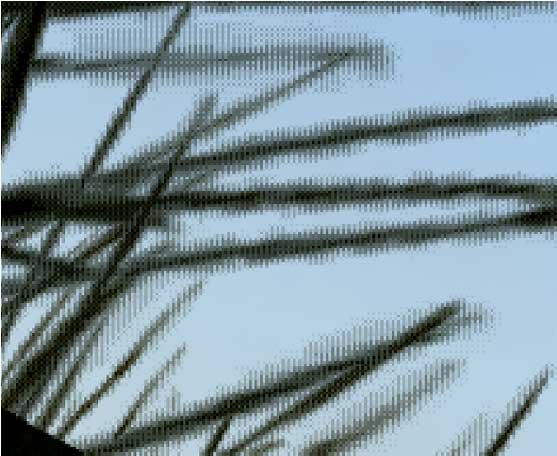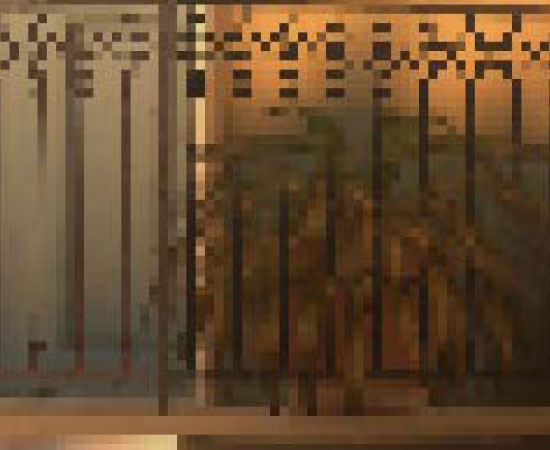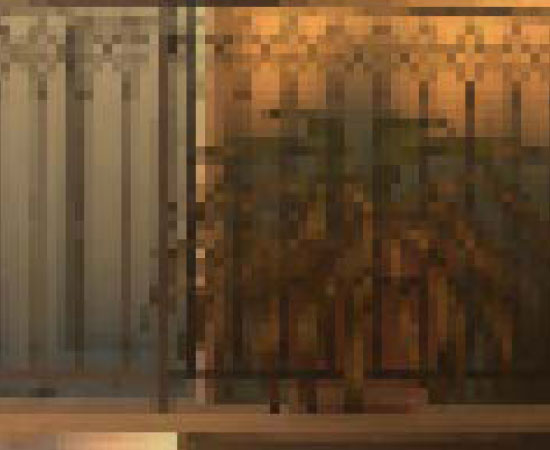Better Image Quality: CSAA & TMAA
NVIDIA’s next big trick for image quality is that they’ve revised Coverage Sample Anti-Aliasing. CSAA, which was originally introduced with the G80, is a lightweight method of better determining how much of a polygon actually covers a pixel. By merely testing polygon coverage and storing the results, the ROP can get more information without the expense of fetching and storing additional color and Z data as done with a regular sample under MSAA. The quality improvement isn’t as pronounced as just using more multisamples, but coverage samples are much, much cheaper.

32x CSAA sampling pattern
For the G80 and GT200, CSAA could only test polygon edges. That’s great for resolving aliasing at polygon edges, but it doesn’t solve other kinds of aliasing. In particular, GF100 will be waging a war on billboards – flat geometry that uses textures with transparency to simulate what would otherwise require complex geometry. Fences, leaves, and patches of grass in fields are three very common uses of billboards, as they are “minor” visual effects that would be very expensive to do with real geometry, and would benefit little from the quality improvement.
Since billboards are faking geometry, regular MSAA techniques do not remove the aliasing within the billboard. To resolve that DX10 introduced alpha to coverage functionality, which allows MSAA to anti-alias the fake geometry by using the alpha mask as a coverage mask for the MSAA process. The end result of this process is that the GPU creates varying levels of transparency around the fake geometry, so that it blends better with its surroundings.
It’s a great technique, but it wasn’t done all that well by the G80 and GT200. In order to determine the level of transparency to use on an alpha to coverage sampled pixel, the anti-aliasing hardware on those GPUs used MSAA samples to test the coverage. With up to 8 samples (8xQ MSAA mode), the hardware could only compute 9 levels of transparency, which isn’t nearly enough to establish a smooth gradient. The result was that while alpha to coverage testing allowed for some anti-aliasing of billboards, the result wasn’t great. The only way to achieve really good results was to use super-sampling on billboards through Transparency Super-Sample Anti-Aliasing, which was ridiculously expensive given that when billboards are used, they usually cover most of the screen.
For GF100, NVIDIA has made two tweaks to CSAA. First, additional CSAA modes have been unlocked – GF100 can do up to 24 coverage samples per pixel as opposed 16. The second change is that the CSAA hardware can now participate in alpha to coverage testing, a natural extension of CSAA’s coverage testing capabilities. With this ability CSAA can test the coverage of the fake geometry in a billboard along with MSAA samples, allowing the anti-aliasing hardware to fetch up to 32 samples per pixel. This gives the hardware the ability to compute 33 levels of transparency, which while not perfect allows for much smoother gradients.
The example NVIDIA has given us for this is a pair of screenshots taken from a field in Age of Conan, a DX10 game. The first screenshot is from a GT200 based video card running the game with NVIDIA’s 16xQ anti-aliasing mode, which is composed of 8 MSAA samples and 8 CSAA samples. Since the GT200 can’t do alpha to coverage testing using the CSAA samples, the resulting grass blades are only blended with 9 levels of transparency based on the 8 MSAA samples, giving them a dithered look.

Age of Conan grass, GT200 16x AA
The second screenshot is from GF100 running in NVIDIA’s new 32x anti-aliasing mode, which is composed of 8 MSAA samples and 24 CSAA samples. Here the CSAA and MSAA samples can be used in alpha to coverage, giving the hardware 32 samples from which to compute 33 levels of transparency. The result is that the blades of grass are still somewhat banded, but overall much smoother than what the GT200 produced. Bear in mind that since 8x MSAA is faster on the GF100 than it was GT200, and CSAA has very little overhead in comparison (NVIDIA estimates 32x has 93% of the performance of 8xQ), the entire process should be faster on GF100 even if it were running at the same speeds as GT200. Image quality improved, and at the same time the performance improved too.

Age of Conan grass, GF100 32x AA
The ability to use CSAA on billboards left us with a question however: isn’t this what Transparency Anti-Aliasing was for? The answer as it turns out is both yes and no.
Transparency Anti-Aliasing was introduced on the G70 (GeForce 7800GTX) and was intended to help remove aliasing on billboards, exactly what NVIDIA is doing today with MSAA. The difference is that while DX10 has alpha to coverage, DX9 does not – and DX9 was all there was when G70 was released. Transparency Multi-Sample Anti-Aliasing (TMAA) as implemented today is effectively a shader replacement routine to make up for what DX9 lacks. With it, DX9 games can have alpha to coverage testing done on their billboards in spite of DX9 not having this feature, allowing for image quality improvements on games still using DX9. Under DX10 TMAA is superseded by alpha to coverage in the API, but TMAA is still alive and well due to the large number of older games using DX9 and the large number of games yet to come that will still use DX9.
Because TMAA is functionally just enabling alpha to coverage on DX9 games, all of the changes we just mentioned to the CSAA hardware filter down to TMAA. This is excellent news, as TMAA has delivered lackluster results in the past – it was better than nothing, but only Transparency Super-Sample Anti-Aliasing (TSAA) really fixed billboard aliasing, and only at a high cost. Ultimately this means that a number of cases in the past where only TSAA was suitable are suddenly opened up to using the much faster TMAA, in essence making good billboard anti-aliasing finally affordable on newer DX9 games on NVIDIA hardware.
As a consequence of this change, TMAA’s tendency to have fake geometry on billboards pop in and out of existence is also solved. Here we have a set of screenshots from Left 4 Dead 2 showcasing this in action. The GF100 with TMAA generates softer edges on the vertical bars in this picture, which is what stops the popping from the GT200.

Left 4 Dead 2: TMAA on GT200

Left 4 Dead 2: TMAA on GF100










115 Comments
View All Comments
Stas - Tuesday, January 19, 2010 - link
all that hype just sounds awful for nVidia. I hope they don't leave us for good. I like AMD but I like competition more :)SmCaudata - Monday, January 18, 2010 - link
The 50% larger die size will kill them. Even if the reports of lower yields are false they will have to get a much smaller profit margin on their cards than AMD to stay competetive. As it is the 5870 can run nearly any game on a 30" monitor with everything turned up at a playable rate. The target audience for anything more than a 5870 is absurdly small. If Nvidia does not release a mainstream card the only people that are going to buy this beast are the people that have been looking for a reason not to buy and AMD card all along.In the end I think Nvidia will loose even more market share this generation. Across the board AMD is the fastest card at every price point. That will not change and with the dual GPU card already out from ATI it will be a long time before Nvidia has the highest performing card because I doubt they will release a dual GPU card at launch if they are having thermal issues with a single GPU card.
BTW... I've only ever owned Nvidia cards but that will likely change at my next system build even after this "information."
Yojimbo - Monday, January 18, 2010 - link
what do you mean by "information"?SmCaudata - Monday, January 18, 2010 - link
Heh. Just that it was hyped up so much and we really didn't get much other than some architectural changes. I suppose that maybe this is really interesting to some, but I've seen a lot of hardware underperform early spec based guesses.The Anandtech article was great. The information revealed by Nvidia was just okay.
qwertymac93 - Monday, January 18, 2010 - link
I really hope fermi doesn't turn into "nvidias 2900xt". late, hot, and expensive. while i doubt it will be slow by any stretch of the imagination, i hope it isn't TOO hot and heavy to be feasible. i like amd, but nvidia failing is not good for anybody. higher prices(as we've seen) and slower advancements in technology hurt EVERYONE.alvin3486 - Monday, January 18, 2010 - link
Nvidia GF100 pulls 280W and is unmanufacturable , details it wont talk about publiclyswaaye - Monday, January 18, 2010 - link
Remember that they talked all about how wondrous NV30 was going to be too. This is marketing folks. They can have the most amazing eye popping theoretical paper specs in the universe, but if it can't be turned into something affordable and highly competitive, it simply doesn't matter.Put another way, they haven't been delaying it because it's so awesome the world isn't ready for it. Look deeper. :D
blowfish - Monday, January 18, 2010 - link
This was a great read, but it made my head hurt!I wonder how it will scale, since the bulk of the market is for more mainstream cards. (the article mentioned lesser derivatives having less polymorph engines)
Can't wait to see reviews of actual hardware.
Zool - Monday, January 18, 2010 - link
Iam still curious why is nvidia pushing this geometry so hard. With 850 Mhz the cypress should be able to make 850mil polygons/s with one triangel/clock speed. Now thats 14 mil per single frame max at 60fps which is quite unrealistic. Thats more than 7 triangels per single pixel in 1920*1050. Making that amount of geometry in single pixel is quite waste and also botlenecks performance. U just wont see the diference.Thats why amd/ati is pushing also adaptive tesselation which can reduce the tesselation level with copute shader lod to fit a reasonable amount of triangels per pixel.
I can push teselation factor to 14 in the dx9 ATI tesselation sdk demo and reach 100fps or put it on 3 and reach 700+ fps with almost zero difference.
Zool - Tuesday, January 19, 2010 - link
Also want to note that just tesselation is not enough and u always use displacement mapping too. Not to mention u change the whole rendering scene to more shader demanding(shadows,lightning) so to much tesselation (like in uniengine heaven on almost everything, when without tesselation even stairs are flat) can realy make big shader hit.If u compare the graphic quality before tesselation and after in uniengine heaven i would rather ask what the hell is taken away that much performance without tesselation as everything looks so flat like in a 10y old engine.
The increased geometry setup should bring litle to no performance advantage for gf100, the main fps push are the much more eficience shaders with new cache architecture and the more than double the shaders of course.